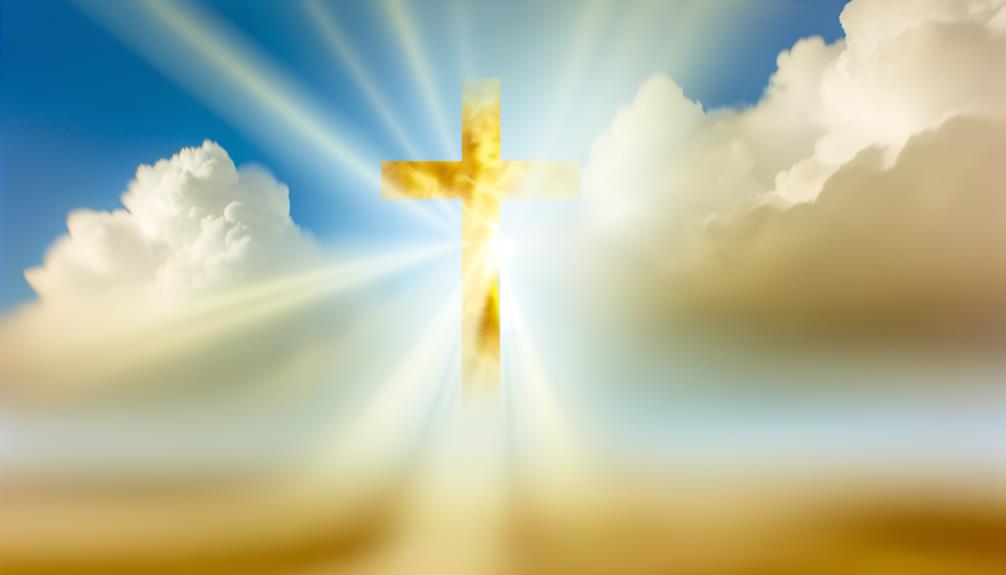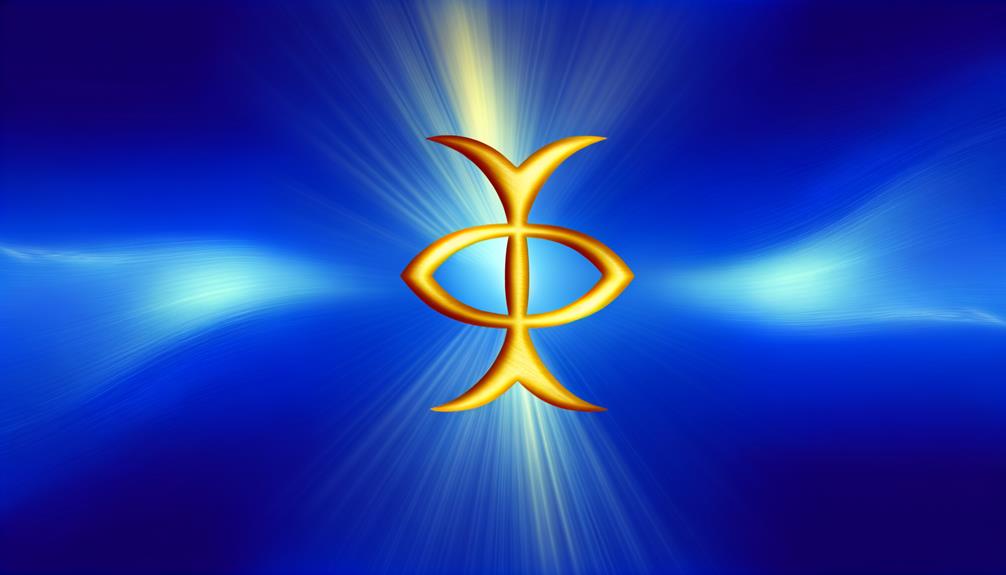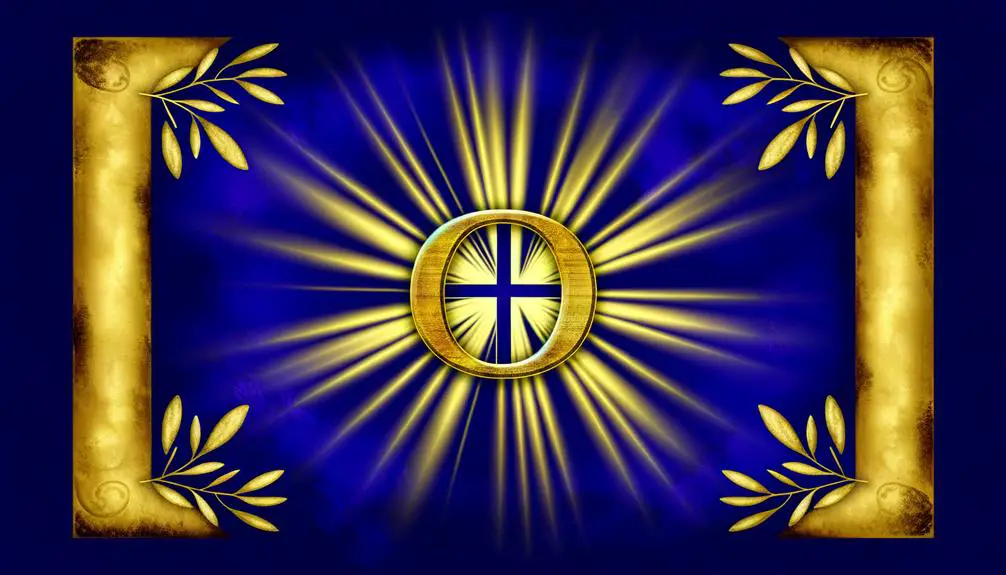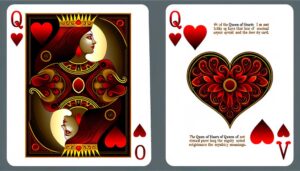What Is the Meaning of Symbols in Christianity?
Christianity employs various symbols to encapsulate its profound theological and spiritual teachings. The Cross, the paramount symbol, signifies sacrifice and redemption through Jesus Christ.
The Ichthys, an early Christian fish symbol, represents faith and the continuity of Christian heritage. The Dove symbolizes the Holy Spirit and divine peace.
The Lamb, emblematic of purity and sacrifice, alludes to Jesus as the 'Lamb of God'. The Alpha and Omega denote Christ's eternal nature, and the Chi-Rho encapsulates divine victory over sin and death.
Each symbol serves as a powerful attestation to the beliefs and doctrines central to the Christian faith. Discover their deeper spiritual resonances further.

Key Takeaways
- The Cross represents Jesus Christ's crucifixion, sacrifice, and redemption.
- The Ichthys, a fish symbol, signifies early Christian faith and Jesus Christ as the Savior.
- The Dove symbolizes peace and the Holy Spirit's divine presence and guidance.
- The Lamb represents Jesus Christ's sacrificial role, purity, and redemption for humanity.
- The Alpha and Omega epitomize Christ's eternal nature and ultimate authority.
The Cross

The Cross stands as the quintessential symbol of Christianity, embodying the profound sacrifice and redemption at the heart of the faith. Rooted in the crucifixion of Jesus Christ, it encapsulates theological concepts of atonement and salvation.
The vertical beam represents the connection between humanity and the divine, while the horizontal beam signifies the reconciliation of human relationships. This dual symbolism underscores the holistic nature of Christian redemption.
Moreover, the Cross serves as a visual and spiritual reminder of Christ's victory over sin and death, offering believers hope and the promise of eternal life. Its pervasive use in liturgy, art, and ritual underscores its centrality, making it an indispensable emblem of Christian identity and devotion.
The Ichthys

The Ichthys, or fish symbol, serves as a profound emblem in early Christian symbolism, often utilized as a covert sign to identify fellow believers during periods of persecution. Its Greek acronym, translating to 'Jesus Christ, Son of God, Savior,' encapsulates core Christian beliefs and functioned as a clandestine code among the faithful.
In contemporary times, the Ichthys continues to hold significant resonance, symbolizing enduring faith and continuity of early Christian heritage.
Early Christian Symbolism
Early Christian symbolism deeply embodies the essence of faith, with the Ichthys serving as a discreet yet powerful emblem of the believers' clandestine devotion.
The Ichthys, or the 'Jesus Fish,' represents a confluence of theological and cultural significances, rooted in the Greek acronym for 'Jesus Christ, Son of God, Savior.'
This symbol, often depicted as two intersecting arcs, was utilized by early Christians to subtly convey their faith amidst persecution.
The choice of a fish, an element deeply embedded in the New Covenant narratives, underscores the intimate relationship between Christ and His followers.
Hence, the Ichthys not only acted as a spiritual identifier but also as a reflection of the resilience and unity of the early Christian community.
Secret Codes and Meanings
In the clandestine milieu of early Christian communities, the Ichthys emerged not only as a symbol of faith but also as a sophisticated secret code, encapsulating profound theological truths and offering a means of discreet identification among believers.
The term 'Ichthys' is derived from the Greek word for fish, yet each letter also serves as an acronym: 'Iēsous Christos, Theou Yios, Sōtēr' (Jesus Christ, Son of God, Savior). This encapsulation of core Christian doctrine allowed early Christians to communicate their faith covertly during periods of persecution.
The Ichthys, drawn as a simple fish outline, became a silent yet powerful proof to shared belief, fostering unity and resilience within an oppressed but spiritually robust community.
Modern-Day Usage
Today, the Ichthys continues to serve as a potent symbol within Christian communities, embodying both historical significance and contemporary faith. Originating as a covert emblem among early Christians to signify their faith amidst persecution, the Ichthys now adorns various mediums—car decals, jewelry, and digital spaces—reaffirming identity and belief.
Its form, a simple outline of a fish, represents the Greek acronym for 'Jesus Christ, Son of God, Savior,' encapsulating core theological tenets. Contemporary usage underscores the enduring relevance of ancient symbols, bridging past and present.
The Dove

The dove, a potent symbol within Christianity, embodies the concepts of peace and the Holy Spirit, often signifying divine presence and guidance. Its appearance at Jesus' baptism underscores themes of purity and renewal, aligning with the sacrament's transformative essence.
This emblematic bird thereby offers a rich tapestry of theological insights central to Christian doctrine and practice.
Peace and Holy Spirit
As a profound emblem in Christian iconography, the dove symbolizes both peace and the presence of the Holy Spirit, encapsulating the essence of divine tranquility and spiritual guidance. This dual symbolism is deeply embedded in Christian theology and liturgy, highlighting the dove's role in representing God's peace and the indwelling Holy Spirit. The dove's appearance during pivotal biblical events, such as Jesus' baptism, underscores its significance in conveying God's will and presence.
| Symbol | Represents | Biblical Reference |
|---|---|---|
| Dove | Peace | Genesis 8:11 |
| Dove | Holy Spirit | Matthew 3:16 |
| Dove | Divine Guidance | Luke 3:22 |
| Dove | God's Presence | John 1:32 |
This table illustrates key scriptural instances where the dove symbolizes foundational Christian beliefs.
Baptism and Purity
Intricately tied to the sacrament of baptism, the dove symbolizes purity and the cleansing of sin, reflecting the transformative power of this sacred rite in Christian doctrine.
The dove's appearance at Jesus' baptism, as described in the Gospels, underscores its significance as a divine emblem of the Holy Spirit's presence and approval.
In Christian theology, baptism is not merely a ritualistic act but a profound spiritual rebirth, where individuals are cleansed of original sin and initiated into the faith community.
The purity of the dove serves as a poignant reminder of the believer's new, sanctified life. This symbol reinforces the doctrine of purification and renewal, central to the Christian understanding of salvation and divine grace.
The Lamb

Among the myriad symbols in Christianity, the lamb holds profound theological significance, encapsulating themes of sacrifice, purity, and redemption.
Central to this symbolism is Jesus Christ, often referred to as the 'Lamb of God' (John 1:29), whose sacrificial death is seen as a fulfillment of Old Covenant sacrificial systems.
The lamb's unblemished nature symbolizes purity and innocence, qualities attributed to Christ's sinless life. The Passover lamb, whose blood protected Israelites during the Exodus, prefigures Christ's redemptive sacrifice for humanity's salvation.
In Revelation 5:12, the lamb is extolled as worthy to receive 'power and wealth and wisdom and strength,' signifying Christ's ultimate victory over sin and death.
Therefore, the lamb encapsulates core Christian doctrines.
The Alpha and Omega

The designation 'Alpha and Omega,' rooted in the Greek alphabet's first and last letters, epitomizes the eternal and all-encompassing nature of Christ in Christian theology. This symbol underscores the belief that Christ is both the beginning and the end of all things, as affirmed in the Book of Revelation (1:8; 22:13).
It is a profound tribute to the omnipresence and omnipotence of Christ, encapsulating the Christian understanding of divine sovereignty over the cosmos. The Alpha and Omega serve as a cornerstone for comprehending Christ's role in creation and eschatology, reinforcing the doctrinal view that His existence transcends temporal boundaries, offering a framework for understanding His perpetual presence and ultimate authority in the Christian faith.
The Chi-Rho

Emerging as one of the earliest Christograms, the Chi-Rho symbol intricately intertwines the Greek letters Chi (Χ) and Rho (Ρ) to signify Jesus Christ.
This powerful icon, often superimposed to form a monogram, serves as a profound attestation to the early Christian community's faith.
Historically, the Chi-Rho was prominently used by Emperor Constantine, most significantly in the Battle of the Milvian Bridge, where it was believed to herald divine victory.
Theologically, the Chi-Rho encapsulates the dual nature of Christ—both divine and human.
Its usage on vestments, liturgical items, and Christian art underscores its enduring spiritual resonance.
For believers, the Chi-Rho remains a poignant reminder of Christ's presence and triumph over sin and death.
Conclusion
In the sacred symphony of Christianity, symbols serve as silent sentinels, speaking volumes about faith and fortitude.
The Cross, Ichthys, Dove, Lamb, Alpha and Omega, and Chi-Rho collectively convey the core convictions and celestial commitments of the Christian creed.
These emblematic elements encapsulate eternal truths, guiding the faithful toward divine destiny.
Through these powerful portrayals, believers find both solace and strength, ensuring that the essence of Christianity endures eternally, echoing through every epoch and era.




